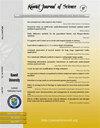Heat and mass transfer analysis of peristaltic flow of Reiner-Rivlin fluid in a flexible curved channel
IF 1.1
4区 综合性期刊
Q3 MULTIDISCIPLINARY SCIENCES
引用次数: 0
Abstract
This study investigates the peristaltic transport of a Reiner-Rivlin non-Newtonian fluid through a curved channel with compliant walls, incorporating heat and mass transfer effects. The main aim of the study is to provide the theoretical framework for applications with a peristaltic flow of complex fluid in different biological systems/biomedical equipment in a curved path. This theoretical framework is also applicable to the cardiovascular behavior and the designs of biomedical devices such as dialysis systems. The governing equations for momentum, energy, and concentration are formulated, and closed-form analytical solutions are obtained via a regular perturbation technique for small wavenumbers. Key findings reveal that curvature dramatically alters flow dynamics: velocity profiles transition from asymmetric (tilted toward the inner wall at low curvature) to symmetric (parabolic at high curvature), mimicking the geometric influence of blood vessels. The Reiner-Rivlin parameter approximately reduces 26 % of flow velocity compared to Newtonian fluids due to increased elastic solid-like behavior. As Reiner-Rivlin fluid has more shear thickening behavior, increasing the fluid parameter enhances the apparent viscosity, which leads to slower flow. The Soret effect drives concentration gradients approximately 38 %, with higher thermal diffusion promoting particle migration to cooler regions. Streamline patterns show that trapped bolus size diminishes with curvature, approaching straight-channel symmetry. These results provide critical insights into biological flows (e.g., gastrointestinal motility, vascular transport) and biomedical device design.
柔性弯曲通道中Reiner-Rivlin流体蠕动流动的传热传质分析
本研究研究了赖纳-里夫林非牛顿流体在弯曲通道内的蠕动输运,并考虑了传热和传质效应。本研究的主要目的是为复杂流体在不同生物系统/生物医学设备中弯曲路径的蠕动流动应用提供理论框架。这一理论框架也适用于心血管行为和生物医学设备的设计,如透析系统。建立了动量、能量和浓度的控制方程,并通过小波数的正则摄动技术获得了封闭形式的解析解。主要发现表明,曲率显著地改变了流动动力学:速度分布从不对称(低曲率时向内壁倾斜)转变为对称(高曲率时抛物线形),模拟了血管的几何影响。与牛顿流体相比,Reiner-Rivlin参数由于增加了弹性类固体行为,大约降低了26%的流速。由于Reiner-Rivlin流体具有更强的剪切增稠性,增大流体参数会增大表观粘度,导致流动速度变慢。Soret效应驱动浓度梯度约38%,较高的热扩散促进颗粒向较冷区域迁移。流线图案表明,被困的颗粒大小随着曲率的减小而减小,接近直线通道对称。这些结果为生物流动(如胃肠道运动、血管运输)和生物医学设备设计提供了重要见解。
本文章由计算机程序翻译,如有差异,请以英文原文为准。
求助全文
约1分钟内获得全文
求助全文
来源期刊

Kuwait Journal of Science
MULTIDISCIPLINARY SCIENCES-
CiteScore
1.60
自引率
28.60%
发文量
132
期刊介绍:
Kuwait Journal of Science (KJS) is indexed and abstracted by major publishing houses such as Chemical Abstract, Science Citation Index, Current contents, Mathematics Abstract, Micribiological Abstracts etc. KJS publishes peer-review articles in various fields of Science including Mathematics, Computer Science, Physics, Statistics, Biology, Chemistry and Earth & Environmental Sciences. In addition, it also aims to bring the results of scientific research carried out under a variety of intellectual traditions and organizations to the attention of specialized scholarly readership. As such, the publisher expects the submission of original manuscripts which contain analysis and solutions about important theoretical, empirical and normative issues.
 求助内容:
求助内容: 应助结果提醒方式:
应助结果提醒方式:


